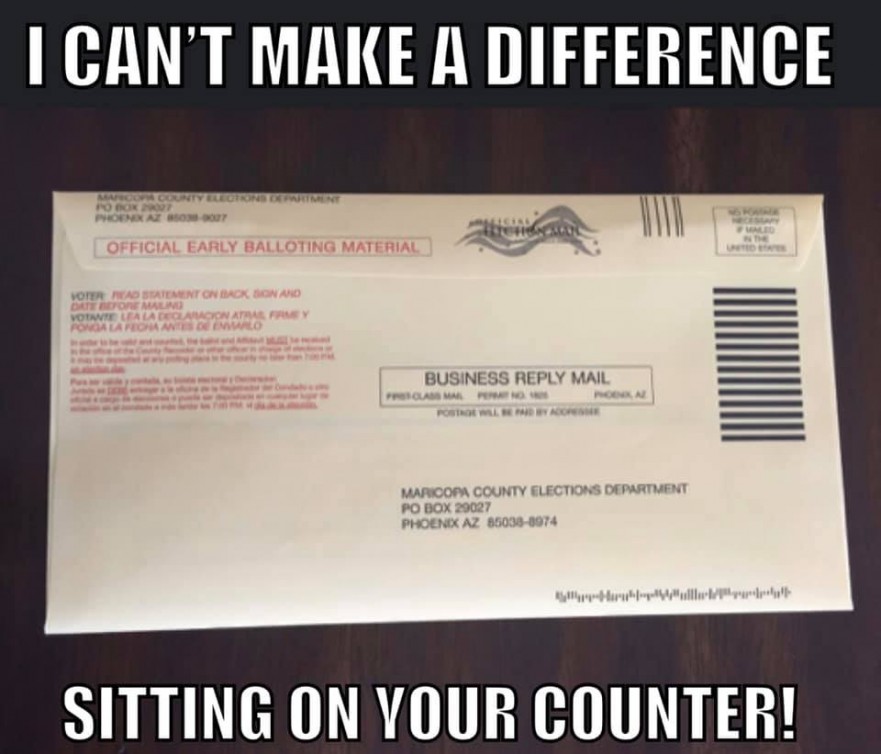Our bond and override election didn’t pass. Initially, I didn’t know what to say when everyone asked me in an incredulous tone “So…what happened there?” I’m trying not to be bitter about my hours of door-knocking. I’m trying to ignore my fears about the quality of my daughter’s education. I’m trying to be happy for all the other districts in the county.
It’s tempting in the Surprise/Peoria area to blame the residents of Sun City. I have been guilty in past losing elections of blaming our large retiree population for voting against educating the next generation because their own kids are grown.
As President Obama said, “You can’t let your failures define you – you have to let them teach you.” So, what have I learned?
The statistics point to apathy in parents of school-aged children and our staff. 26% of eligible voters voted in Surprise and El Mirage. A mere 5,000 of those votes were from people 50 and under. Our bond failed to pass by only 365 votes, which equates to needing only 15 more Yes votes per Dysart school to pass. In the words of my friend and Yes for Dysart champion Beth Simek, “It would take all of 30 seconds to fill in the mail-in ballot. It could not have been easier or more convenient.”
It was frustrating that the override failed to pass by 3,433 votes, as it is not a new tax, like the bond, but merely a continuation of the override already in place. In a district of about 24,000 students and 2,800 staff, we had the numbers to easily pass both funding measures. (Huge thanks to my Dysart colleague and Yes for Dysart champion Jenna Kaderlik for the statistics!)
Some people who voted no argue that school safety is a luxury and that athletics and the arts don’t impact scholarly performance and academics. Some people who voted no are still angry that teachers dared to raise our voices and walkout to demand better for our students during the #redfored movement. Some people who voted no fail to see the value of an educated society. At least they voted.
I asked Beth Simek her thoughts on the reasons behind our dismal 26% voter turnout. She said, “The only thing I can think of is that it has to personally hurt people before they will get up and act. In 2014 our override failed. Dysart cut full-day kindergarten, lost 143 teachers, and programs were canceled to compensate for the lack of funding. Families were very upset; teachers and staff were frustrated and everyone finally took note of what all this really meant. Why? Because this hurt personally.” I wish coworkers didn’t have to lose jobs, students didn’t have to lose classes, and we didn’t have to experience such pain. But our community seems to need to suffer dire consequences before it is compelled to act – or vote.
Where do we go from here? How do you fight apathy? How do you argue with people who couldn’t be bothered to connect two lines, sign and mail in a PRE-PAID ENVELOPE? engage people, inspire voters, and compel our community to proudly take ownership of itself and its best interests?
As Beth and I shared our bitter feelings, she wisely told me that the only ones affected by our bitterness is us. No voters or non-voters don’t care about our feelings. They aren’t upset that we’re upset.
Melissa Grimscheid, a colleague from Peoria, the other major loss in this election cycle (their override lost by 149 votes), told me that we have supportive communities. We see this in our school functions and day to day interactions. Yet their voting habits don’t reflect that…yet.
A life lesson I learned long ago is one of tenacity – giving up is the only sure way to fail. “Failure is something we can avoid only by saying nothing, doing nothing, and being nothing” (Denis Waitley). I am nothing if not tenacious, vocal, and active. I will continue to fight for more equitable and transparent funding structures in our state. I’m going to keep sharing my classroom reality with my friends, family, neighbors, etc. I will do what I do best – teach. I will teach my community the value of a vote for education.










Comments 4
Such a great reflection on how apathy harms our schools…in times of elections and every single day in between. Congratulations on having the wisdom and maturity to get lessons from such a great loss! Hoping the Dysart community comes together in future support of your scholars and staff! I know you will be bravely leading the way
I have to say, I was quick to put the blame on Sun City, too. The statistics you provided shine a much clearer picture and I look forward to sharing them with my West-side friends (who I made sure voted, and voted YES, of course). Thank you for always advocating for your district, classroom, and all the students of Arizona and supporting others in doing the same.
Thank you for this post. I live in the West Valley and work downtown. It is hard to for me to stay connected with what is going on in my local home schools. I usually limit my involvement to the ballot, but I am thinking I need to take a deeper look. For what it is worth, I do hear comments from persons in my home communities that are not sure about boundaries, districts, and the relationship between West Valley gowth (i.e. assumptions of city income increases) and our schools/districts.
Thank you for a reflective post. Advocating for better supported public schools can be a very frustrating endeavor at times. I admire all of the time and effort you commit to raising awareness about public school needs. The message will eventually get through and we will all benefit from your tenacity. Thank you!